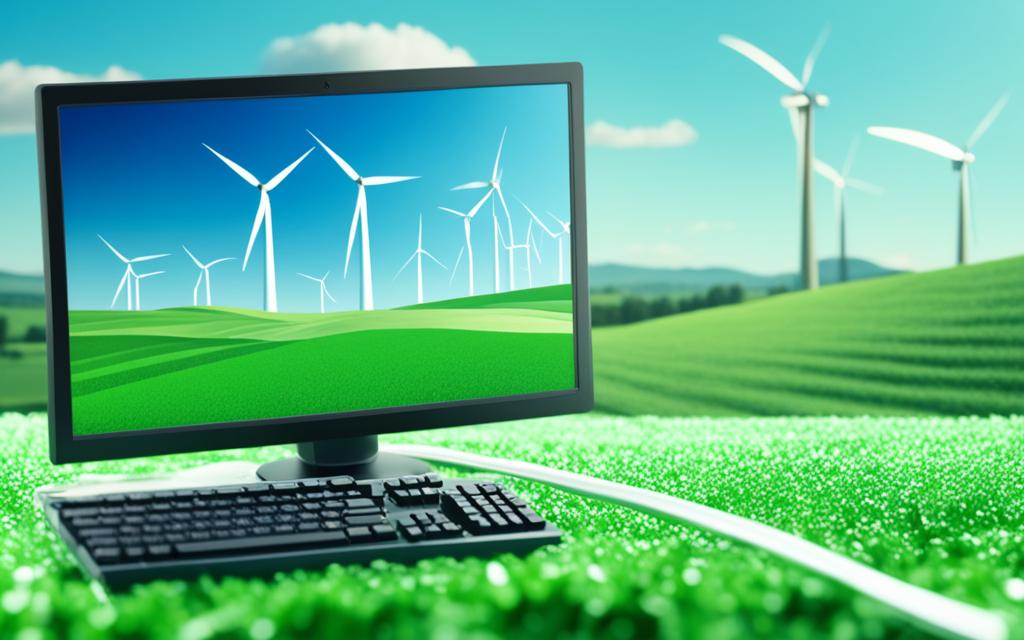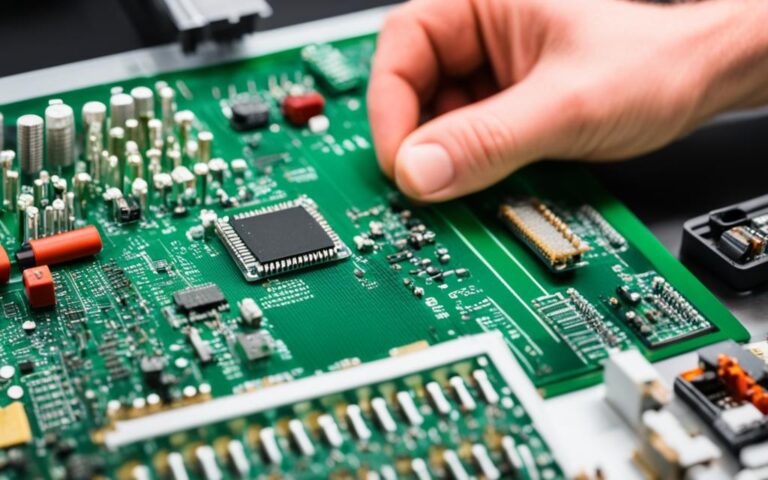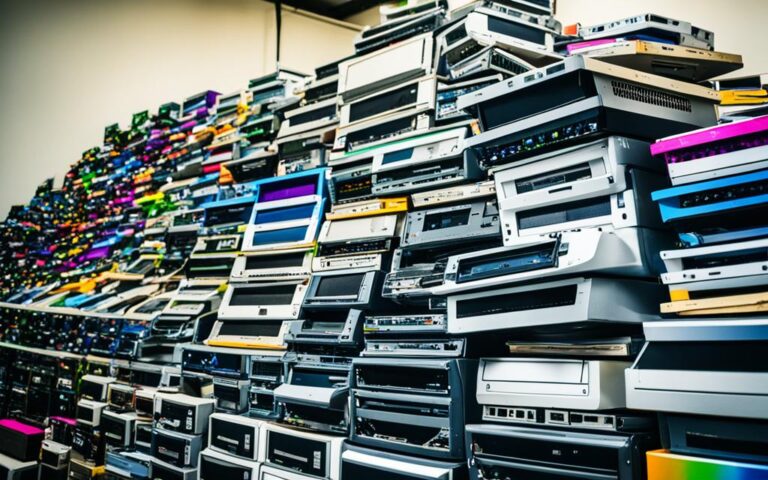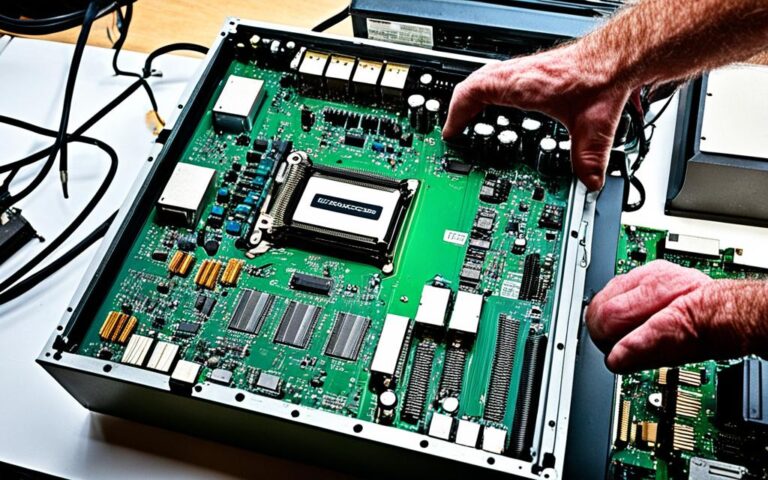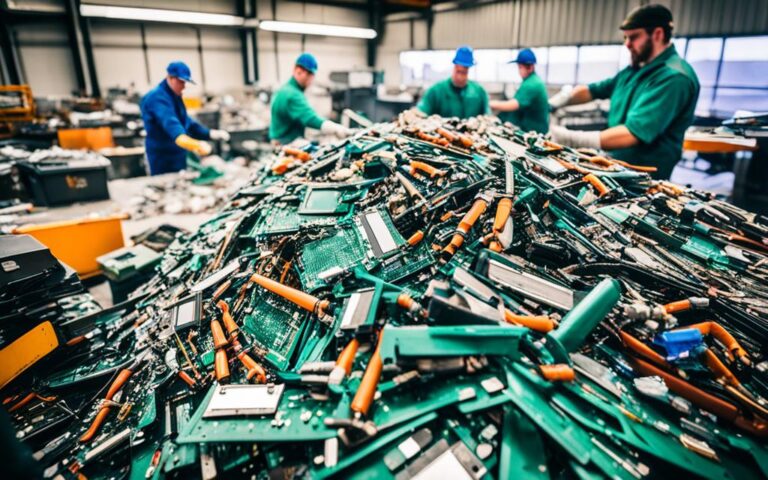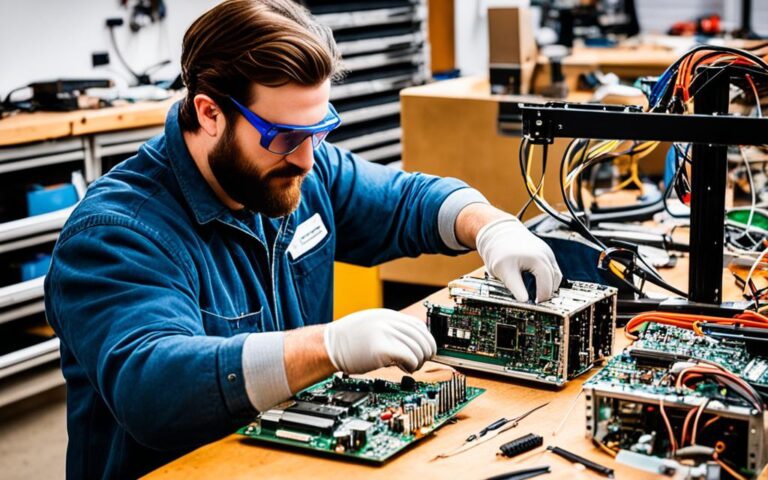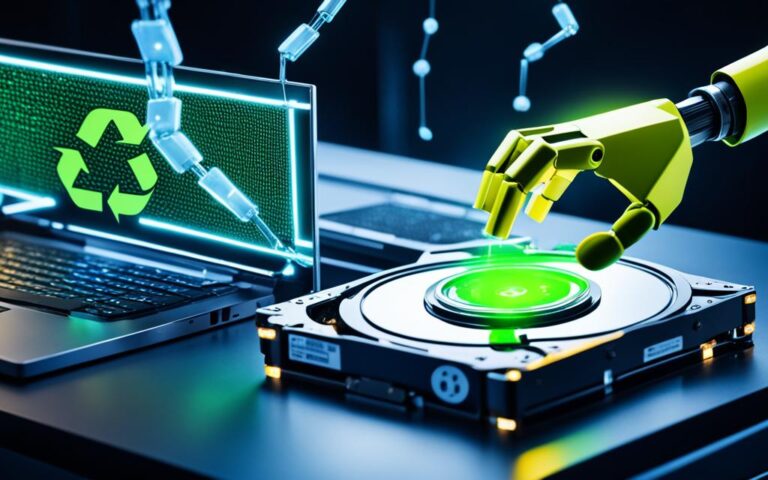Managing the End of the Computer Lifecycle
Proper end-of-life management is crucial for the sustainable disposal of computer equipment in the United Kingdom. As technology advances at a rapid pace, the need for responsible handling of outdated computers becomes more important than ever. From reducing environmental impact to promoting resource efficiency, sustainable practices in the computer lifecycle play a vital role in creating a greener future.
When we think about the lifespan of a computer, the end-user phase is just one part of the equation. In fact, only 34% of the total energy consumption of a computer occurs during its actual use. The remaining stages, such as mining, manufacturing, packaging, and transportation, account for a significant portion of the computer’s environmental impact.
Buying electronic products that are EPEAT registered promotes sustainable material selection and end-of-life management. This encourages the use of eco-friendly materials and reduces waste in the UK. By choosing products with a focus on sustainability, consumers and businesses can contribute to the responsible disposal of computers and minimize their environmental footprint.
In the following sections, we’ll explore the various stages of the computer lifecycle in more detail. We’ll delve into the impact of mining and manufacturing, the importance of sustainable packaging and shipping, the energy consumption during the usage phase, and the significance of recycling and responsible disposal.
It’s time to take a closer look at how we can close the loop and create a more sustainable computer industry in the UK. Together, we can make a difference.
The Impact of Mining and Manufacturing
Computers are composed of more than 30 different minerals that are extracted from the earth, including silica, iron, aluminum, copper, lead, zinc, and more. These minerals are nonrenewable resources, making it crucial to promote sustainable mining practices in order to use them responsibly and protect the environment.
The process of mining computer minerals can have significant environmental consequences, such as deforestation, habitat destruction, and water pollution. Sustainable mining practices aim to minimize these impacts by implementing measures that reduce waste generation, optimize resource extraction, and promote community engagement.
The Challenges of Sustainable Mining
Sustainable mining poses several challenges due to the complexity of mineral extraction processes and the need for international collaboration. These challenges include:
- Ensuring social and environmental responsibility throughout the supply chain
- Promoting transparency and accountability in mining operations
- Minimizing waste generation and implementing efficient resource management
- Supporting local communities and indigenous rights
Addressing these challenges requires the cooperation of governments, mining companies, and consumers to drive change and create a more sustainable future for mining practices.
The Energy-Intensive Manufacturing Process
The manufacturing of computers is an energy-intensive process that involves various stages, including the transportation of materials from different parts of the world to assembly plants. This transportation contributes to greenhouse gas emissions and increases the carbon footprint of the manufacturing process.
In addition to energy consumption, the manufacturing process also generates waste and pollutants, such as electronic waste and hazardous chemicals. To mitigate these impacts, manufacturers can adopt sustainable manufacturing practices that prioritize energy efficiency, waste reduction, and the use of environmentally friendly materials.
Comparison of Sustainable Mining Initiatives
| Initiative | Description |
|---|---|
| Fairtrade Gold Certification | A certification scheme that ensures small-scale gold miners receive fair compensation and adhere to environmental and labor standards. |
| Conflict-Free Minerals Programs | Programs designed to prevent the use of minerals sourced from conflict zones, where mining contributes to human rights abuses and funding of armed groups. |
| Responsible Minerals Initiative | A multi-industry initiative that aims to improve transparency and responsible sourcing of minerals, focusing on conflict minerals and human rights abuses. |
“Sustainable mining and manufacturing processes are essential for minimizing the environmental impact of computer production. By promoting responsible mining practices and adopting sustainable manufacturing strategies, we can protect our planet’s resources and create a more sustainable computer industry.” – [Insert industry expert name]
Packaging and Shipping
Once the manufacturing process is complete, computers undergo packaging to ensure safe transportation. This stage plays a critical role in protecting the devices from damage during transit. Various materials such as plastic, styrofoam, and cardboard are commonly used in computer packaging.
Computer packaging has evolved over the years to meet the demands of an increasingly globalized market. The use of sturdy materials and cushioning ensures that computers arrive at their destinations in pristine condition. Additionally, packaging is designed to meet international shipping standards, ensuring compliance with regulations and minimizing the risk of damage.
However, it is important to consider the environmental impact of computer packaging. The materials used, particularly plastic and styrofoam, contribute to waste generation and marine pollution. These non-biodegradable materials can take hundreds of years to decompose, posing a threat to ecosystems.
Moreover, the transportation of packaged computers, often from overseas, contributes to carbon dioxide (CO2) emissions. The reliance on fossil fuels for shipping increases transportation emissions, further exacerbating the environmental impact of computer distribution.
To address these challenges, companies are exploring sustainable alternatives for computer packaging. Biodegradable and recyclable materials, such as plant-based plastics and recycled cardboard, offer a more environmentally friendly solution. By adopting sustainable packaging practices, companies can minimize waste and reduce their carbon footprint.
“Sustainable packaging plays a crucial role in minimizing the environmental impact of computer distribution. As consumers, we should support initiatives that prioritize eco-friendly materials and responsible packaging practices.”
It is crucial for businesses and consumers to prioritize sustainable packaging practices to reduce the environmental impact of computer distribution. By choosing products with eco-friendly packaging and supporting companies committed to responsible transportation, we can contribute to a more sustainable future.
| Environmental Impact of Computer Packaging and Shipping | Consequences |
|---|---|
| Waste generation | Plastic and styrofoam packaging materials contribute to non-biodegradable waste. |
| Marine pollution | Improper disposal of packaging materials can lead to marine pollution, affecting aquatic ecosystems. |
| CO2 emissions | The transportation process releases a significant amount of CO2 into the atmosphere due to the reliance on fossil fuels. |
| Sustainable alternatives | Adoption of biodegradable and recyclable materials can mitigate the environmental impact of computer packaging and shipping. |
The Usage Phase
During the usage phase of a computer’s lifecycle, electricity consumption plays a significant role. The electricity that powers computers is often generated from nonrenewable sources such as coal, petroleum, or natural gas. This reliance on fossil fuels not only contributes to greenhouse gas emissions but also accelerates climate change.
However, there are steps that individuals and organizations can take to reduce electricity usage and improve energy efficiency. Implementing power-saving settings on computers and other electronic devices can help minimize energy consumption during periods of inactivity. Furthermore, taking the simple action of shutting off and unplugging electronics when not in use can significantly reduce standby power consumption, also known as phantom power.
Investing in energy-efficient products is another effective way to reduce electricity usage. Energy Star certified computers and peripherals are designed to consume less power without compromising performance. These devices incorporate advanced technologies that optimize energy efficiency, helping to lower electricity bills and reduce environmental impact.
“By adopting energy-saving habits and using energy-efficient products, we can each make a positive impact on the environment while reducing our electricity consumption.”
By prioritizing energy efficiency and reducing electricity usage, we can contribute to the larger goal of sustainability and environmental conservation. Making conscious choices in our computer usage habits and investing in energy-efficient technologies not only benefits the planet but also brings economic advantages through cost savings on electricity bills.
Energy-Saving Tips for Reducing Electricity Usage:
- Enable power-saving settings on computers and electronic devices
- Shut off and unplug electronics when not in use
- Invest in Energy Star certified computers and peripherals
- Use natural daylight or energy-efficient lighting options in the workspace
- Turn off unnecessary lights and use task lighting where needed
- Consider using smart power strips to eliminate standby power consumption
- Optimize computer performance by regularly updating software and hardware
- Utilize sleep or hibernation modes when taking breaks
| Energy-Saving Action | Estimated Electricity Savings |
|---|---|
| Enabling power-saving settings | Up to 50% |
| Shutting off and unplugging electronics | Up to 10% |
| Using Energy Star certified devices | Up to 25% |
| Optimizing computer performance | Up to 15% |
Closing the Loop – Recycling and Disposal
Proper disposal and recycling of computers are crucial for reducing the energy and resources required in the early stages of their life cycle. When a computer reaches the end of its life, it can be recycled, donated, or repurposed to minimize its environmental impact. In the United Kingdom, companies like IT-Recycle offer server recycling services to ensure responsible disposal of computer equipment.
Computer recycling involves the recovery and reuse of valuable materials, such as metals and plastics, found in old computers. By recycling these materials, we can conserve natural resources, reduce the demand for mining and manufacturing, and minimize the amount of electronic waste that ends up in landfills or incinerators.
However, it’s important to choose a reputable and certified recycling service provider to ensure that the recycling process is done responsibly and ethically. Improper disposal practices can lead to environmental pollution and health hazards due to the presence of hazardous substances in electronic waste.
Companies like IT-Recycle specialize in server recycling, ensuring that decommissioned servers go through a proper recycling process. They employ environmentally friendly methods to safely handle data destruction, asset recovery, and parts recycling. Their services adhere to regulatory standards and ensure compliance with data protection and environmental legislation.
Benefits of Computer Recycling and Responsible Disposal
Computer recycling and responsible disposal offer several benefits:
- Conservation of Resources: Recycling computers helps conserve valuable resources like metals, plastics, and rare earth elements. By reusing these materials, we reduce the need for new resource extraction.
- Environmental Protection: Proper recycling prevents hazardous substances from entering the environment, minimizing soil and water pollution.
- Data Security: Certified recycling services ensure secure data destruction, protecting sensitive information from falling into the wrong hands.
- Compliance with Regulations: Responsible disposal ensures compliance with data protection and environmental regulations, avoiding legal penalties and reputational damage.
- Sustainable Practices: By choosing to recycle and dispose of computers responsibly, individuals and organizations contribute to a more sustainable and circular economy.
Server Recycling Services in the UK
IT-Recycle, a leading provider of computer recycling services in the UK, offers specialized server recycling solutions. Their comprehensive services include secure data destruction, equipment collection, recycling, and certification. By partnering with IT-Recycle, businesses can ensure the responsible disposal of their decommissioned servers while also supporting sustainable practices.
By choosing server recycling services in the UK, companies can actively participate in the circular economy, reduce their carbon footprint, and contribute to a more sustainable future.
Remember, computer recycling and responsible disposal are essential for minimizing the environmental impact of computers and ensuring a sustainable future for generations to come.
Conclusion
Responsible computer lifecycle management and sustainable practices are essential for reducing the environmental impact of computer usage. Each stage of a computer’s life, from sustainable mining and manufacturing to responsible disposal and recycling, plays a crucial role in minimizing resource consumption and carbon emissions.
By adopting energy-efficient practices such as implementing power-saving settings and shutting off unused electronics, individuals and organizations can significantly reduce electricity consumption and contribute to a greener future.
Supporting initiatives like EPEAT, which encourages sustainable material selection and end-of-life management, is another way to promote responsible computer lifecycle management. Through these efforts, we can build a more sustainable and environmentally friendly computer industry.
FAQ
What is end-of-life management for computers?
End-of-life management refers to the proper disposal and recycling of computers once they reach the end of their usable life. It involves recycling, donating, or repurposing the equipment to minimize the environmental impact.
What is sustainable mining?
Sustainable mining refers to the practice of extracting minerals from the Earth in an environmentally responsible manner. It involves minimizing the negative impact on ecosystems, using resources efficiently, and promoting the well-being of local communities.
How does the manufacturing process impact the environment?
The manufacturing process of computers is energy-intensive and requires the transportation of materials from around the world to assembly plants. This contributes to the consumption of energy and the release of CO2 emissions, adding to the environmental impact.
What materials are used in computer packaging?
Computer packaging typically includes materials such as plastic, styrofoam, and cardboard to ensure safe transportation. These materials, however, contribute to waste and CO2 emissions during the shipping process.
How can I reduce the environmental impact of computer usage?
To reduce the environmental impact of computer usage, you can implement power-saving settings, shut off and unplug electronics when not in use, and buy energy-efficient products. These actions help to minimize electricity consumption and reliance on fossil fuel energy sources.
How can I responsibly dispose of my computer equipment in the UK?
In the UK, you can responsibly dispose of computer equipment by utilizing services provided by companies like IT-Recycle, who offer server recycling services. It ensures that the equipment is recycled or disposed of properly, minimizing the energy and resources needed in the initial stages of a computer’s life.
Why is responsible computer lifecycle management important?
Responsible computer lifecycle management is crucial for minimizing the environmental impact of computer usage. From sustainable mining and manufacturing processes to proper disposal and recycling, every stage of a computer’s life should be approached with sustainability in mind to reduce resource depletion and contribute to a more sustainable and responsible computer industry.

